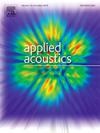Snake optimization improved multivariate multiscale slope entropy and its application to multivariate signal feature extraction
IF 3.4
2区 物理与天体物理
Q1 ACOUSTICS
引用次数: 0
Abstract
The multivariate slope entropy (mvSloEn) is an effective metric for characterizing the complexity of multi-channel time series. However, mvSloEn ignores the correlation between symbol patterns from different channels, making it difficult to comprehensively characterize the complexity of multi-channel signals. To address this issue, this paper proposes the improved mvSloEn (ImvSloEn), which fuses the information of symbol patterns from different channels and extends the symbol pattern types by constructing multiple pattern components, thus comprehensively characterizing the multi-channel signal complexity. To reflect the complexity of different time scales, improved multivariate multiscale slope entropy (ImvMSloEn) is introduced as a multi-scale version of ImvSloEn. Furthermore, snake optimization ImvMSloEn (SO-ImvMSloEn) is presented, which solves the threshold selection for ImvMSloEn. To the end, a multivariate signal feature extraction method is proposed in combination with multivariate variational mode decomposition (MVMD) and SO-ImvMSloEn. Simulation experiments demonstrate that SO-ImvMSloEn can accurately characterize the complexity of multivariate signals and the proposed multivariate feature extraction method can distinguish chaotic signals more accurately. Real-world experiments proved that the proposed multivariate feature extraction method has higher classification accuracy for rolling bearing signals and ship radiated noises compared to other feature extraction method.
求助全文
约1分钟内获得全文
求助全文
来源期刊

Applied Acoustics
物理-声学
CiteScore
7.40
自引率
11.80%
发文量
618
审稿时长
7.5 months
期刊介绍:
Since its launch in 1968, Applied Acoustics has been publishing high quality research papers providing state-of-the-art coverage of research findings for engineers and scientists involved in applications of acoustics in the widest sense.
Applied Acoustics looks not only at recent developments in the understanding of acoustics but also at ways of exploiting that understanding. The Journal aims to encourage the exchange of practical experience through publication and in so doing creates a fund of technological information that can be used for solving related problems. The presentation of information in graphical or tabular form is especially encouraged. If a report of a mathematical development is a necessary part of a paper it is important to ensure that it is there only as an integral part of a practical solution to a problem and is supported by data. Applied Acoustics encourages the exchange of practical experience in the following ways: • Complete Papers • Short Technical Notes • Review Articles; and thereby provides a wealth of technological information that can be used to solve related problems.
Manuscripts that address all fields of applications of acoustics ranging from medicine and NDT to the environment and buildings are welcome.
 求助内容:
求助内容: 应助结果提醒方式:
应助结果提醒方式:


